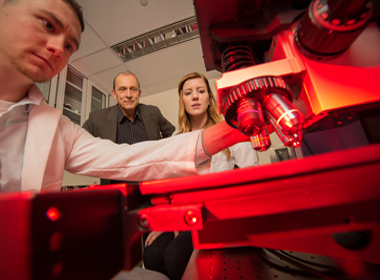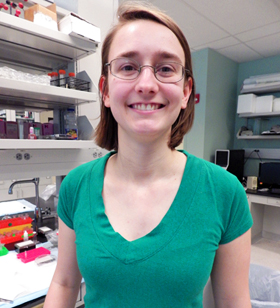UAlbany Patented CSI Technique Gets Law Enforcement Testing
 |
|
UAlbany chemist Igor Lednev's research lab has developed a patented technique involving microscopic analysis of biological and chemical samples. (Photo by Paul Miller)
|
ALBANY, N.Y. (May 9, 2016) -- University at Albany forensic scientist Igor Lednev has been refining a technique for improving crime scene analysis for nearly a decade. His research involves Raman Spectroscopy, a method which uses scattered light to perform microscopic analysis of biological and chemical samples. Funded through the National Institute of Justice, Lednev’s project has resulted in a patent issued in 2013 for "Identification of body fluids using raman spectroscopy."
The project is now entering a new phase, as the U.S. Army Criminal Investigation Command’s Defense Forensic Science Center (DFCS) is undertaking steps to validate and implement the technology for biological stain identification by Army Crime Laboratories. DFCS and UAlbany will undertake a year-long educational partnership agreement, with Lednev’s team doing initial testing on a new Raman device, which will then be returned to DFSC for implementation.
The goal of the agreement is to develop spectroscopic libraries and software specifically for the instrument. The project also provides fellowship support for a UAlbany Ph.D. student, Marisia Fikiet, through the Army Educational Outreach Program. The Dean’s Office of the College of Arts and Sciences is covering the tuition that allows Fikiet to work on the project.
"This is a great opportunity to advance the patented technology developed at the University," said Lednev, a professor in the Department of Chemistry. "For the first time, the method will be tested by an outside law enforcement agency, which serves as recognition of work that has been supported through the National Institute of Justice grant."
 |
|
UAlbany doctoral student Marisia Frikiet
|
"I am really honored to have the opportunity to work closely with practicing forensic scientists from the DFSC and expand the field of forensic research," said Fikiet, who is originally from Storrs, Conn. "It is really exciting to get to help take a technique from the laboratory to real-world applications. I am also thrilled to be able to eventually go to Georgia (where DFCS is located) and demonstrate our method."
Body fluid traces recovered at crime scenes are among the most common and important types of forensic evidence. However, the current biochemical techniques for identifying a biological stain at a crime scene are destructive, and a separate test for each individual body fluid is required.
Lednev’s team has developed an approach that uses multidimensional Raman signatures for confirmatory identification of all main body in a nondestructive way. The technology is applicable to dry traces contaminated with sand, dust, and soil. The ability to overcome the contamination interference is one of the most promising aspects of Lednev’s approach.
Raman spectroscopy has been known for years as the most selective spectroscopic technique. Recent advancements in laser technology and digital cameras have made Raman spectroscopy even more reliable, inexpensive and non-destructive. Further, it can be used in the field, with numerous practical applications ranging from industrial process control to material science, and pharmaceutical, geological, forensic and medical diagnostics.
If the crime lab tests the methodology and it is found to be effective, it could potentially become the standard approach undertaken by all Army crime labs.
![]() For more news, subscribe to UAlbany's RSS headline feeds
For more news, subscribe to UAlbany's RSS headline feeds
A comprehensive public research university, the University at Albany-SUNY offers more than 120 undergraduate majors and minors and 125 master's, doctoral and graduate certificate programs. UAlbany is a leader among all New York State colleges and universities in such diverse fields as atmospheric and environmental sciences, business, education, public health,health sciences, criminal justice, emergency preparedness, engineering and applied sciences, informatics, public administration, social welfare and sociology, taught by an extensive roster of faculty experts. It also offers expanded academic and research opportunities for students through an affiliation with Albany Law School. With a curriculum enhanced by 600 study-abroad opportunities, UAlbany launches great careers.


